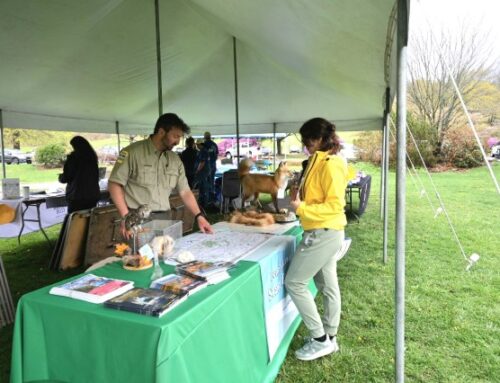Alaska agency boosting gas line asks skeptical Legislature to consider investing up to $80
April 26, 2025

JUNEAU — The state agency advocating for a $44 billion gas line in Alaska is asking the Legislature to consider investing up to $800 million in the long-sought but faltering megaproject.
There has been renewed interest in building an 800-mile gas pipeline from the North Slope since President Donald Trump announced his strong support for the project. Several Asian nations have shown an interest in investing in the pipeline and buying gas from Alaska, but no concrete deals have yet been signed.
Gov. Mike Dunleavy and Alaska’s three-member, all-Republican congressional delegation have been bullish on the Alaska LNG project. Some lawmakers have been equally optimistic, but multiple legislators said they remain skeptical that the pipeline will be built, particularly on the fast timeline touted by the project’s new private developer.
Frank Richards, president of Alaska Gasline Development Corp., told legislators this week about the upsides of the project. It has been fully permitted and is eligible for $28 billion in federal loan guarantees, he said.
Delegates from South Korea and Thailand are set to come to Alaska soon to study the project, AGDC officials said this week. Additionally, the Trump administration is urging leaders of several Asian nations to commit to the pipeline with representatives set to attend a June summit in Alaska, The New York Times reported.
[South Korea and other Asian countries plan visits to the state as they eye Alaska LNG project]
The renewed interest in the pipeline comes after AGDC — the state agency leading the project — announced in January that Glenfarne had signed on to become its lead developer.
ADVERTISEMENT
The terms of AGDC’s deal with Glenfarne, a New York-based company, remain confidential. But AGDC told lawmakers this week that Glenfarne agreed to take a 75% stake in exchange for bringing the project to a final investment decision — a pivotal step in completing a megaproject.
Richards said Wednesday that Glenfarne had recently “suspended” calls for an Alaska development agency to provide $50 million as an insurance policy for remaining engineering and design work. Instead, Richards said Glenfarne would be willing to use private capital to complete that work, which is estimated to cost $150 million.
‘It is in our future’
In recent months, some lawmakers have been buoyed by the prospects for the project.
Anchorage GOP Rep. Chuck Kopp penned an opinion piece in the Daily News encouraging Alaskans to “shake the cynicism off.” Fellow Anchorage Republican Rep. Mia Costello introduced a legislative resolution that urges support for “the rapid advancement” of the pipeline.
“We really will be having a gas line. It is in our future,” Costello said at a Tuesday media conference.
Still, multiple lawmakers said while they support the pipeline, they have lingering doubts and questions. Some legislators have been skeptical about the project’s costs and timelines; others have questioned why Glenfarne, a relatively new player in the oil and gas sector, was chosen as the lead developer.
Richards said other offers were discussed, but Glenfarne got the tick of approval from AGDC’s board and investment bank Goldman Sachs.
Some lawmakers have bristled at what they say is the Legislature’s limited oversight of the project.
In 2014, the Legislature approved Senate Bill 138, which granted AGDC broad authority to develop the pipeline.
Republican former House Speaker Mike Chenault, a current AGDC board member, said the agency’s independence was by design. He said that gives AGDC the ability to make decisions in a timely matter.
“I believe that if the Legislature gets involved, that this project will go away,” he said.
With Southcentral Alaska facing a looming shortfall of natural gas from Cook Inlet, the pipeline has been touted as a way to secure gas supply for Alaska in the long term. But the project is also being discussed as a way to fill state coffers.
Officials at AGDC said the state’s current stake in the project could potentially raise hundreds of millions of dollars per year in new revenue, but that is still set to be negotiated with Glenfarne and any other potential investors.
There is an opportunity for Alaska to invest substantially more in the project to collect more revenue for the state, Richards said.
“The big question for the state of Alaska going forward is really going to be around that equity financing,” he said Wednesday to a joint legislative committee.
The project has recently been split into phases. The first phase would see an 807-mile gas pipeline built from the North Slope to Nikiski. The second phase would see plants built to treat gas and prepare it for export.
Richards told lawmakers that the state, Alaska Native corporations, Alaska businesses and individual Alaskans could invest up to 25% in those subprojects. For the pipeline, that would cost roughly $800 million. For the pipeline and two plants, the cost would be over $3.5 billion, AGDC board members said earlier in the month.
ADVERTISEMENT
The Legislature is currently grappling with strained revenue and a dire fiscal outlook, making it unlikely that it could fund the 25% stake in the pipeline, lawmakers said.
Anchorage Republican Sen. Cathy Giessel said that she had heard little interest from lawmakers for the state to put “money into this project.” Giessel, chair of the Senate Resources Committee, said “$800 million, of course, is an absurd amount.”
Timing, tailwinds and wariness
Project timelines have also been greeted with skepticism by veteran legislators.
Richards told lawmakers this week that a final investment decision could be reached by the end of the year. A pipeline could be constructed and delivering gas for Alaskans by 2030 or 2031, he said.
During a joint legislative committee hearing, House Speaker Bryce Edgmon said that there seemed to be “missing key ingredients” in answers to legislators’ questions from AGDC. Edgmon, a Dillingham independent, suggested that the 2031 timeline seemed “more aspirational than it is reality.”
The costs of the project have also come under scrutiny. The full gas line project was estimated in 2023 to cost $44 billion, AGDC board members said. The pipeline itself was expected then to cost just under $11 billion.
Rep. Zack Fields, D-Anchorage, said that the trans-Alaska pipeline was completed in 1977 at a cost of $8 billion. He said that the gas pipeline is expected to cost 37% more than TAPS, but that inflation has increased prices more than five-fold over the past 48 years.
Fields asked how that cost estimate for the gas pipeline could be “plausible.”
ADVERTISEMENT
Warren Christian, an AGDC board member, said the project’s costs were carefully calculated by ExxonMobil.
An updated cost estimate is expected after engineering and design work is completed, AGDC officials said.
While pipeline discussions continue, concrete plans have been advancing to import gas for Southcentral Alaska. Gas line boosters said the project could be a viable long-term fix for the state’s energy needs.
Veteran legislators say they’ve heard that before.
Anchorage Democratic Sen. Bill Wielechowski said there seemed to be some positive “tailwinds” behind the project, citing interest from the Trump administration and in Asia. But Wielechowski estimated this was the eighth version of the pipeline he’s heard pitched during his 18-year tenure in the Legislature.
“I’m a bit wary at this point, just based on promises we’ve heard in the past,” he said. “New administrations, new people come in and it sounds great, and then, for whatever reason, it just doesn’t work.”
As an example, he pointed to TransCanada. In 2008, the Legislature approved paying up to $500 million for the Calgary-based company to help with pre-construction costs. Seven years later, the Legislature appropriated $64 million to buy out TransCanada’s stake in the project.
Wielechowski said the state should consider investing in the pipeline to raise more state revenue for Alaska. But echoing many in the Capitol, he remained somewhat doubtful the project would come to fruition.
“I want it to happen. I share the sentiment that I think many Alaskans share — I’ll believe it when I see it,” he said.
Search
RECENT PRESS RELEASES
Related Post




